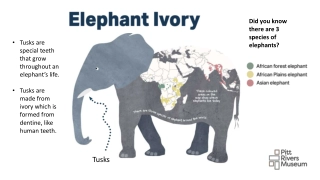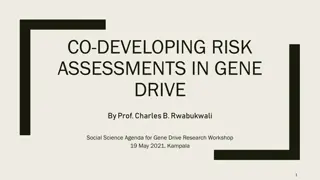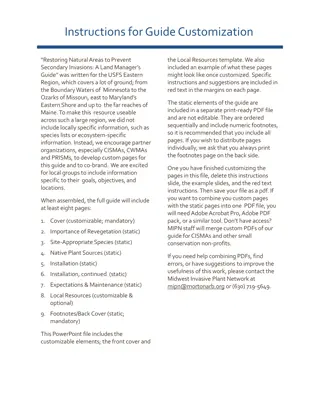The Endangered Species in Information Technology: Challenges and Solutions
Gender disparities in access to and impact of ICTs, cultural barriers, and gender bias hinder women's participation in Information Technology. The EU's initiatives on e-inclusion and gender equality aim to address these challenges, promoting digital inclusion and diverse participation in the tech sector.
Download Presentation

Please find below an Image/Link to download the presentation.
The content on the website is provided AS IS for your information and personal use only. It may not be sold, licensed, or shared on other websites without obtaining consent from the author.If you encounter any issues during the download, it is possible that the publisher has removed the file from their server.
You are allowed to download the files provided on this website for personal or commercial use, subject to the condition that they are used lawfully. All files are the property of their respective owners.
The content on the website is provided AS IS for your information and personal use only. It may not be sold, licensed, or shared on other websites without obtaining consent from the author.
E N D
Presentation Transcript
The Endangered Species in Information Technology Nasrin Rahmati PhD, MIS Dar Al-Hekma University
Outline ICT & Gender Workforce Problems Theoretical Background Summary results Next Stage 2
ICTs are not gender neutral Substantial gender differences in access to, impact of ICTs Few women users in developing countries Most women users in developing countries part of small, educated urban elite In developed countries few women are expected to take up the available ICT posts. 3
Social and cultural issues Women have less access than men to those facilities that do exist Women have less time to visit public access facilities Facilities may not be located where women are comfortable frequenting Hours may not be conducive to women s use 4
Gender bias towards women and ICTs Fewer women in science and technology (Lack of Role Models) Attitudes that information technology is not for women (Male dominated Professions) Other cultural aspects limit women s access 5
EU Key Themes 1 Preventing digital division (e-inclusion) 2 Infrastructure 3 Modern, service-oriented public administration 4 More competitive SMEs through ICT 5 ICT literacy 6 Security of ICT applications 7 High quality e-content 6
EU: Gender & e-Inclusion eEurope Action Plan 2005 focused above all on users, male and female. At all levels and for all activities full social participation was paramount Opportunities to participate may vary from person to person because of socioeconomic (income, ancestry, education) and sociocultural (gender) barriers. 7
EU Gender & e-Inclusion For various reasons women are under represented both in research and development and also in founding new companies concerned with the application of the new ICT technologies. 63% of men and 50% of women over 14 years are online (2005) 8
EU Gender & e-Inclusion EQUAL EU initiative to fight discrimination and inequality in the labor market has specific programs to support women and ICT 9
The Problem of Gender & ICT Women are not minorities in the US population In 2004, women accounted for: 59.2% of the population over 16 56% of the labor force (U.S. Bureau of Labor Statistics 2005) Female participation increasing in some historically male-dominated professions (US) Legal: 9.5% female (1971) to 44.4% (1996) 10
The Problem of Gender & ICT The representation of women in the IT profession is declining (ITAA, 2005, 2003) Women are less likely to return to the IT profession after the dot.com bust (ITAA, 2005) 100% 75% 59% 65% 68% 50% 25% 41% 35% 32% 0% Year 1996 2002 2004 Men Women Source (ITAA, 2005; 2003) 11
The Gender & ICT Problem The Problem for Application Women are under represented with respect to information & communications technology (ICT) design, development & application Are women under served with respect to ICT use? 12
The Gender & ICT Problem Why should we care? Addressing ICT labor shortages (Gender) diversity & innovation (Gender) diversity & economic development Diversity of products & services Increasing social inclusion & social access, and decreasing digital gap 13
24.7 Computer and mathematical occupations - Computer and information research scientists 34.2 Computer systems analysts United States Department of Labor Bureau of Labor 19.7 Information security analysts 21.0 Computer programmers 17.9 Software developers, applications and systems software http://www.bls.gov/cps/cpsaat11.htm 34.3 Web developers 26.4 Computer support specialists Feb 2016 38.0 Database administrators 15.9 Network and computer systems administrators 12.1 Computer network architects 24.3 Computer occupations, all other - Statistics Actuaries - Mathematicians 50.7 Operations research analysts 52.9 Statisticians 14 Miscellaneous mathematical science occupations
The Gender & ICT Problem The Problem for Research Providing the quantitative & qualitative data to support the gender inequality claims Developing & testing theoretically-informed, empirically-grounded interventions to equalize gender representation in production and consumption of ICT 15
The Gender & ICT Problem Choosing an appropriate theoretical lens for critically understanding this data Theory: shedding constructive light on the issue or reinforcing unproductive & negative stereotypes? 16
Gendered Technology? Is technology (& ICT) gender neutral? What is needed to overcome the gender imbalance in technological areas? 17
Social Cognitive Theory Social Cognitive Theory started as Social Learning Theory in 1960s by Albert Bandura. In 1986 it developed into the Social Cognitive Theory. The three factors environment, people and behaviour are constantly influencing each other. Behaviour is not simply the result of the environment and the person, just as the environment is not simply the result of the person and behaviour (Glanz et al, 2002). The environment provides models for behaviour. Behavioural capability means that if a person is to perform a behaviour he must know what the behaviour is and have the skills to perform it. 18
Social Cognitive Theory Scope and Application The Social Cognitive explains how people acquire and maintain certain behavioural patterns. The theory can also be used for providing the basis for intervention strategies Favorite Methods Surveys, experiments and quasi-experiments are used. See for therapeutical techniques Bandura (1997) and Glanze et al (2002) Source: Pajares (2002). Overview of social cognitive theory and of self-efficacy. 12- 8-04. From http://www.emory.edu /EDUCATION/mfp/eff.h tml. 19
Gender Schema Theory Bem (1981) developed the gender schema theory and proposes that sex typing is a learned phenomenon mediated by cognitive processing. Individuals learn society s gender role standards and expectations, and they accordingly develop attitudes and conduct behaviours that society deems gender appropriate (Srite and Karahanna, 2006). Because computing has developed a masculine image similar to the traditionally masculinized subjects such as mathematics, physics and engineering (Agosto, 2004; Gilbert et al., 2003), females tend to feel less comfortable with computers than males (Beyer, 2008; Frankel, 1990; Karsten and Schmidt, 2008; Lowe and Krahn, 1989). Thus, the masculine image of computers may lead many females to, consciously or unconsciously, avoid learning and using computers. 20
Self-Efficacy According to Albert Bandura, self-efficacy is "the belief in one s capabilities to organize and execute the courses of action required to manage prospective situations." In other words, self- efficacy is a person s belief in his or her ability to succeed in a particular situation. Bandura described these beliefs as determinants of how people think, behave, and feel (1994). 21
Gender Schema and Self Efficacy Gender schema theory suggests that females tend to learn less and practice less if they view computers as a male domain. Uneasy feelings with computers may lead females to develop negative attitudes toward computers. Females typically display lower computer aptitude (Beyer, 2008; Felter, 1985; Franz and Robey, 1986; Young, 2000) and feel more anxious about using computers (Harrison et al., 1997; Igbaria and Chakrabarti, 1990; Morrow et al.,1986) when compared with male counterparts. 22
Computer Self-Efficacy Computer self-efficacy is a specific type of self- efficacy. Specific self-efficacy is defined as belief in one s ability to mobilize the motivation, cognitive resources, and courses of action needed to meet given situational demands (Wood & Bandura, 1989, p. 408). Thus, computer self-efficacy is a belief of one s capability to use the computer (Compeau & Higgins, 1995). This belief has an influence on choice of activities, degree of effort expended, and persistence of effort (Bandura, 1986). Therefore, participants with little confidence in their ability to use computers might perform more poorly on computer-based tasks. 23
Computer Self-Efficacy Some studies have selected computer self- efficacy as the main dependent variable for their research on the basis of these two reasons: (1)as a core construct in the social cognitive theory, self-efficacy is widely accepted as a key factor regulating one s computer behaviours; (2)as a fundamental psychological state, self- efficacy shapes one s attitudes and decisions toward IT usage by influencing key beliefs such as perceived ease of use (Davis, 1989; Venkatesh and Davis, 1996). 24
Computer Anxiety Computer anxiety has been defined as a fear of computers when using one, or fearing the possibility of using a computer (Chua, Chen, & Wong, 1999). Computer anxiety is characterized as an affective response. That is, an emotional fear of potential negative outcomes such as damaging the equipment or looking foolish. Computer anxiety has been described as a kind of state anxiety (Cambre & Cook, 1985; Heinssen et al., 1987). From an information-processing perspective, the negative feelings associated with high anxiety detract cognitive resources from task performance (Kanfer & Heggestad, 1997). 25
Computer Anxiety and Computer Self-Efficacy) Several studies have demonstrated the effect of computer anxiety and computer self-efficacy on computer-related behaviours. Computer self-efficacy has been shown to be positively related to performance during computer training (Gist, Schwoerer, & Rosen, 1989; Webster & Martocchio, 1992). A high level of computer anxiety has been negatively related to learning computer skills (Harrington, McElroy, & Morrow, 1990; Jackson, Vollmer, & Stuurman, 1985; Marcoulides, 1988), resistance to the use of computers (Torkzadeh & Angulo, 1992; Weil & Rosen, 1995), and poorer task performance (Heinssen et al., 1987). Together these studies show that these two characteristics can have an important impact on computer use. 26
The Importance of Role Models The lack of female IT role models harms girls in two related ways. First, as girls begin to consider college majors and career paths, the choice of IT fields is not reinforced by respected role models; second, the lack of female role models reinforces some negative stereotypes held by girls and young women about IT field. Specifically, researchers note that the male geek stereotype about computer scientists actively discourages women from considering the field. 27
The Importance of Role Models Once women reach college and enrol in classes, role models and mentors can help them persevere in science and technology majors. Research from several disciplines suggests that the presence of: female peers (Craig 1998), teaching assistants (Butler et al, 2003), and faculty members (Robst et al, 1998) increases female retention in science and technology majors. On the other hand, the absence of female role models and mentors has a clear negative impact. Women cited a lack of role models as a significant reason for leaving the fields of physics, chemistry, electrical engineering, and computer science (Etzkowitz, et al, 1994). 28
Theory of Planned Behaviour Theory of Planned Behaviour based model (see, Ajzen and Fishbein, 1980) is also used to predict intention to pursue an IT career. The theory proposes that a behaviour can be predicted by intentions, which are formed by one s attitude, perceived subjective norms, and the individual s control concerning the behaviour. The Theory of Planned Behaviour suggests that an individual s intention to pursue an IT career is collectively determined by personal interests, social influences and certain factors that control one s behaviours. These factors relate to an individual s attitude toward IT and the perceived social pressures regarding an IT career, and their perceived control over choosing an IT career. 29























